From the legal point of view, the most important change ushered in by the Treaty of Lisbon concerns the scope of the jurisdiction of the Court of Justice of the European Union. This was widened due to the dismantling of the pillar structure. As a general rule, the jurisdiction of the European Courts now covers previous third pillar matters as well, namely criminal law and police co-operation.
The dismantling of the pillar structure did not, however, affect the Common Foreign and Security Policy. The Union Courts still do not have jurisdiction in this area. This rule has two important exceptions.
Although the Area of Freedom, Security and Justice is communitarised and more coherent than before, the previous limits in its territorial scope, namely the opt-outs of the UK, Ireland and Denmark, did not disappear, so limits in the Courts’ jurisdiction remain.
The Treaty of Lisbon amendments did not change the fundamentals of the judicial doctrines, such as the direct effect and primacy of European Union law. Importantly, the application of these doctrines was widened instead, owing to the depillarisation.
The Treaty of Lisbon amendments meant that the decisions of the European Council and European Union bodies, offices and agencies can be reviewed under the preliminary ruling procedure.
The Treaty of Lisbon changed the much-debated criteria for the standing of non-privileged applicants in actions to review the legality of the European Union acts.








